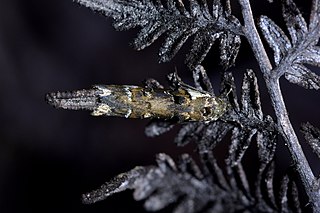
Mycalesis oculus, the red-disc bushbrown, is a satyrine butterfly found in southern India. It is similar in markings to Mycalesis adolphei but distinguished by the reddish band around the large apical spots on the upper forewings.
Stigmella maoriella is a species of moth in the family Nepticulidae. It is endemic to New Zealand. It is classified as Not Threatened by the Department of Conservation.
Compsoctena connexalis is a moth in the family Eriocottidae. It was described by Francis Walker in 1863. It is found in South Africa.
Brachmia alienella is a moth in the family Gelechiidae. It was described by Francis Walker in 1864. It is found in Sri Lanka.
Dichomeris rubiginosella is a moth in the family Gelechiidae. It was described by Francis Walker in 1864. It is found in Mexico, Peru and Amazonas, Brazil.
Dichomeris designatella is a moth in the family Gelechiidae. It was described by Francis Walker in 1864. It is found in Peru and Amazonas, Brazil.
Dichomeris permundella is a moth in the family Gelechiidae. It was described by Francis Walker in 1864. It is found in Peru and Amazonas, Brazil.
Dichomeris sumptella is a moth in the family Gelechiidae. It was described by Francis Walker in 1864. It is found in Peru and Amazonas, Brazil.
Compsolechia abruptella is a moth of the family Gelechiidae. It was described by Francis Walker in 1864. It is found in Amazonas in Brazil and in Peru.
Compsolechia monochromella is a moth of the family Gelechiidae. It was described by Francis Walker in 1864. It is found in Amazonas in Brazil and in Peru.
Compsolechia tardella is a moth of the family Gelechiidae. It was described by Francis Walker in 1864. It is found in Peru and Amazonas, Brazil.
Compsolechia transjectella is a moth of the family Gelechiidae. It was described by Francis Walker in 1864. It is found in Peru and Amazonas, Brazil.
Compsolechia solidella is a moth of the family Gelechiidae. It was described by Francis Walker in 1864. It is found in Amazonas, Brazil.
Lecithocera dissonella is a moth in the family Lecithoceridae. It was described by Francis Walker in 1864. It is found on Borneo.
Deltoplastis amicella is a moth in the family Lecithoceridae. It was described by Francis Walker in 1864. It is found in India (Assam), Myanmar and Sri Lanka.
Antaeotricha confixella is a moth in the family Depressariidae. It was described by Francis Walker in 1864. It is found in Amazonas, Brazil.
Antaeotricha indicatella is a moth in the family Depressariidae. It was described by Francis Walker in 1864. It is found in Amazonas, Brazil.
Imma alienella is a moth in the family Immidae. It was described by Francis Walker in 1864. It is found on Borneo.
Imma quadrivittana is a moth in the family Immidae. It was described by Francis Walker in 1863. It is found in Brazil.

Trachypepla conspicuella is a species of moth in the family Oecophoridae. It is endemic to New Zealand and is found in both the North and South Islands. It is similar in appearance to its close relative T. euryleucota but tends to be paler. Its colouration imitates bird droppings. Larvae feed on leaf litter. Adults of this species are on the wing from November to February and have been observed resting on fences and walls.

